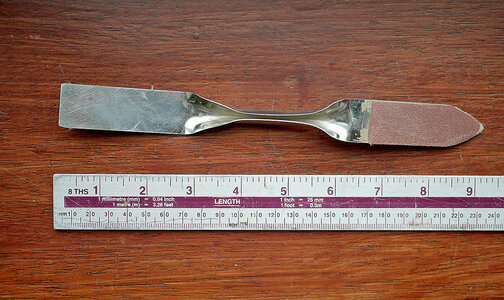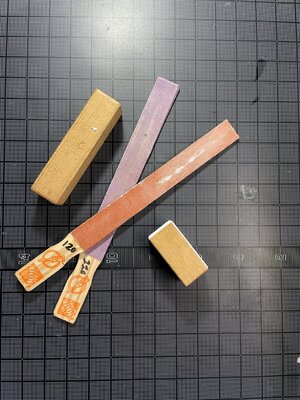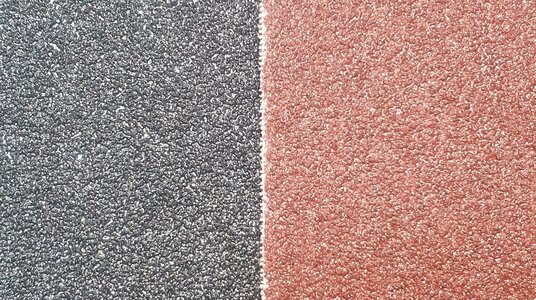tools ! TOOOOOOOLLLSSSSSssss !!!!!I know this store!!
View attachment 407397
View attachment 407401
here is the virtual tour.
Baptist
www.google.com
You are using an out of date browser. It may not display this or other websites correctly.
You should upgrade or use an alternative browser.
You should upgrade or use an alternative browser.
Discussion Use, shapes and materials for Sanding Blocks
- Joined
- Aug 8, 2019
- Messages
- 4,142
- Points
- 688

Lots of Japanese saws, lots.....tools ! TOOOOOOOLLLSSSSSssss !!!!!
- Joined
- Aug 8, 2019
- Messages
- 4,142
- Points
- 688

And next to this shop is the https://www.af.nl/
Niceeeeeeeeeeeeeeeee!And next to this shop is the https://www.af.nl/
- Joined
- Jul 26, 2013
- Messages
- 380
- Points
- 158

I usually just wrap some sandpaper around a Pink Pearl eraser, or use sanding sticks from the beuty supply store.
 www.sallybeauty.com
www.sallybeauty.com
Nail Files, Buffers, & Brushes | Nail Care Products & Accessories | Sally Beauty
Sally Beauty offers a variety salon professional nail files, nail buffers, and nail brushes to help shape and grind fingernails and toenails. Shop now.
Concerning sanding blocks, the best, on my hands, are those that have a rounded shape at the front/back. The flat sanding blocks can hit a piece of , not flat glued wood, with the tip and damage it. The rounded blocks are like the front section of a pair of snow skies.
One that is very practical is cutting a section of 2x4" wood, found everywhere here in USA. Cut the length that you want, round the tips with any sanding tool and wrap around the sand paper. You can keep the sand paper tight with just taping it on the hand side.
One that is very practical is cutting a section of 2x4" wood, found everywhere here in USA. Cut the length that you want, round the tips with any sanding tool and wrap around the sand paper. You can keep the sand paper tight with just taping it on the hand side.
- Joined
- Dec 16, 2016
- Messages
- 1,016
- Points
- 493

I use strips of MDF, dowels, larger sheets of scrap, thin, long strips of basswood, beveled bars of MDF. I even have a few bits of 3D printed bars to get contours. I simply spray on 3M contact cement out back on a garbage liner and mass produce. I have 4 grits, 100,150,240, and 320. I use a gum eraser to discharge pieces from time to time and when the paper doesn't cut anymore, I just peel it off and do another batch of blocks again with the same blocks. They are easy to mass produce, so I always make backups too. Makes for lots of sharp edges. The bigger pieces help to fair frames or allow you to bring smaller pieces to the sanding, making for better and sharper shaping. I mounted a large 150 grit block on a holder for a sharpening stone to keep it and blocks stacked on from slipping ($20) and can get rid of char on large number of pieces quickly.
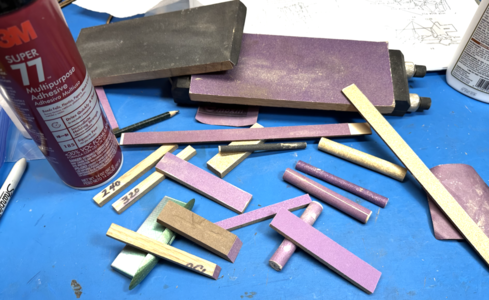
My sandpaper supply is mostly purple. e Moxin? I like 3M best, usually made in Canada, but they seem determined to put non-slip coating on the back. The coating dissolves in the solvent in the contact cement spray, a mess.
Forgive the blue mat. It exactly matches the size of my table top from ULine. I have plenty of green matting from before I bought the table, but can't find anything wrong with the blue.

My sandpaper supply is mostly purple. e Moxin? I like 3M best, usually made in Canada, but they seem determined to put non-slip coating on the back. The coating dissolves in the solvent in the contact cement spray, a mess.
Forgive the blue mat. It exactly matches the size of my table top from ULine. I have plenty of green matting from before I bought the table, but can't find anything wrong with the blue.
Forgive??? The Blue mat?Forgive the blue mat. It exactly matches the size of my table top from ULine. I have plenty of green matting from before I bought the table, but can't find anything wrong with the blue.




 I am also using a 3M brand of sandpaper I like it a lot!
I am also using a 3M brand of sandpaper I like it a lot!- Joined
- Oct 15, 2017
- Messages
- 986
- Points
- 403

I too have many small and some larger pine blocks I use for sanding. @kuba91nt I have watched so many Youtube videos by Russian builders I now think of them as "biscuits". When using Youtube's translation options this is the word that results from the Russian to English translation. And I kind of see them as biscuits now. AND when I was a little boy, my Aunt Libby made biscuits that tasted like Pine wood. This is my imagination of course. I never tried to actually eat Pine wood.The best block is pine 10x6x3cm with 60, 80, 120, 140, 180, 220, 400 sandpaper glued with white glue. The bend has a right angle of 90*. Perfection.
View attachment 407213View attachment 407214
Oh, I just read your post referring to Andrey Kudin's use of them. THIS was the first site I learned about biscuits, as I've watched all of his videos, more than once working on Le Fleuron.
Man ,I love SoS.
- Joined
- Aug 8, 2019
- Messages
- 4,142
- Points
- 688

My aunty made pinewood biscuits to, only they wheren't crunchy at all. They where a little like cork. She make me that I don't like selfmade cookies.Aunt Libby made biscuits that tasted like Pine wood



- Joined
- Oct 15, 2017
- Messages
- 986
- Points
- 403

I think I might have every item posted in this thread up until this post, with exception of Ken's spatula thingy. I surly wish I could un-see certain things and happy the Admiral does not have a spatula that small. It removes all temptation. 
For a minute I was going to put together all my sanding "thingamajigs" and take a photo to post. Then I realized that that would be about 2 hours I'd lose working on my ship by the time I got them all out and put them back. Two drawers worth. Big drawers!
For a minute I was going to put together all my sanding "thingamajigs" and take a photo to post. Then I realized that that would be about 2 hours I'd lose working on my ship by the time I got them all out and put them back. Two drawers worth. Big drawers!
- Joined
- Jan 30, 2023
- Messages
- 250
- Points
- 158

I haven't heard of pine cakes or biscuits, but is something called "pine shoot syrup", maybe Libby used it to make a cake. We use it in Poland to treat the throat.I too have many small and some larger pine blocks I use for sanding. @kuba91nt I have watched so many Youtube videos by Russian builders I now think of them as "biscuits". When using Youtube's translation options this is the word that results from the Russian to English translation. And I kind of see them as biscuits now. AND when I was a little boy, my Aunt Libby made biscuits that tasted like Pine wood. This is my imagination of course. I never tried to actually eat Pine wood.
Oh, I just read your post referring to Andrey Kudin's use of them. THIS was the first site I learned about biscuits, as I've watched all of his videos, more than once working on Le Fleuron.
Man ,I love SoS.
I'm from the eastern bloc, luckily I don't have to translate biscuits movies, but every spring I cut pine shoots to make syrup. This year it will be a pine biscuit, i hope it won't hurt my throat later



- Joined
- Oct 15, 2017
- Messages
- 986
- Points
- 403

My Mother's maiden name was Woychik. As a small boy visiting my Dziadek I remember many great tasting things and some not so great tasting. I think maybe I'm glad I don't remember "pine shoot syrup". It doesn't sound tasty.I haven't heard of pine cakes or biscuits, but is something called "pine shoot syrup", maybe Libby used it to make a cake. We use it in Poland to treat the throat.
I'm from the eastern bloc, luckily I don't have to translate biscuits movies, but every spring I cut pine shoots to make syrup. This year it will be a pine biscuit, i hope it won't hurt my throat later
- Joined
- Jun 17, 2021
- Messages
- 1,665
- Points
- 488

Thanks for the abundant information on this endless topic. every new idea helps. Especially useful, since I am making filler blocks in balsa to fit between the bulkheads of my Mamoli Flying Cloud. Tedious work with many fussy-fiddly and demanding compound curves and precise edges. I find that Elmer's (or reasonable facsimile thereof) glue stick is good for sticking sandpaper down to flat wood blocks. Just give it sufficient time to dry (both surfaces). Peels of easiliy . Cleans up with a damp rag for re-use.
Pete
Pete
I see an interest in the thread, and I want to thank you all who participated. But... how many of us actually know what is the sandpaper made of and how to choose the correct one for a given job? Stay tuned and you will have a chance to learn, thanks to WIKI!!
Sandpaper, also known as glasspaper, is a heavy paper with abrasive material bonded to its surface. Sandpaper is part of the "coated abrasives" family of abrasive products. It is used to remove small amounts of material from surfaces, either to make them smoother (painting and wood finishing), to remove a layer of material (e.g. old paint), or sometimes to make the surface rougher (e.g. as a preparation to gluing).
The first recorded instance of sandpaper was in 13th-century China when crushed shells, seeds, and sand were bonded to parchment using natural gum. Sharkskin was also used as a sandpaper. The rough scales of the living fossil Coelacanth are used by the natives of Comoros as sandpaper. Boiled and dried, the rough horsetail is used in Japan as a traditional polishing material, finer than sandpaper.
Sandpaper was originally known as glass paper, as it used particles of glass. Glass frit has sharp-edged particles and cuts well, sand grains are smoothed down and do not work well like sandpaper made from glass. Cheap counterfeit sandpaper has long been passed off as true glass paper; Stalker and Parker cautioned against it in the 17th century. Glass paper was manufactured by John Oakey's company in London by 1833, who had developed new adhesive techniques and processes, enabling mass production. A process for making sandpaper was patented in the United States on June 14, 1834, by Isaac Fischer, Jr., of Springfield, Vermont.
In 1921, 3M invented a sandpaper with a waterproof backing, known as Wetordry. This allowed use with water, which would serve as a lubricant to carry away particles that would otherwise clog the grit. Its first application was automotive paint refinishing.
Material Materials used for the abrading particles are:
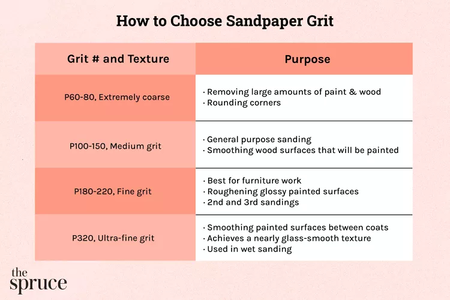
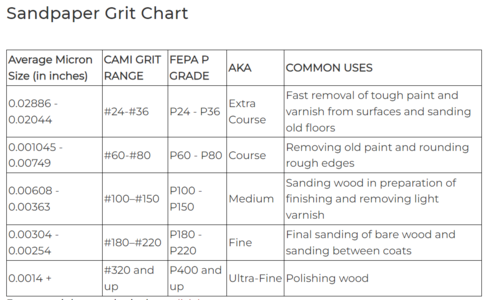
Thank you and enjoy
Sandpaper, also known as glasspaper, is a heavy paper with abrasive material bonded to its surface. Sandpaper is part of the "coated abrasives" family of abrasive products. It is used to remove small amounts of material from surfaces, either to make them smoother (painting and wood finishing), to remove a layer of material (e.g. old paint), or sometimes to make the surface rougher (e.g. as a preparation to gluing).
The first recorded instance of sandpaper was in 13th-century China when crushed shells, seeds, and sand were bonded to parchment using natural gum. Sharkskin was also used as a sandpaper. The rough scales of the living fossil Coelacanth are used by the natives of Comoros as sandpaper. Boiled and dried, the rough horsetail is used in Japan as a traditional polishing material, finer than sandpaper.
Sandpaper was originally known as glass paper, as it used particles of glass. Glass frit has sharp-edged particles and cuts well, sand grains are smoothed down and do not work well like sandpaper made from glass. Cheap counterfeit sandpaper has long been passed off as true glass paper; Stalker and Parker cautioned against it in the 17th century. Glass paper was manufactured by John Oakey's company in London by 1833, who had developed new adhesive techniques and processes, enabling mass production. A process for making sandpaper was patented in the United States on June 14, 1834, by Isaac Fischer, Jr., of Springfield, Vermont.
In 1921, 3M invented a sandpaper with a waterproof backing, known as Wetordry. This allowed use with water, which would serve as a lubricant to carry away particles that would otherwise clog the grit. Its first application was automotive paint refinishing.
Material Materials used for the abrading particles are:
- Flint: no longer commonly used
- Garnet: commonly used in woodworking
- Emery: commonly used to abrade or polish metal
- Aluminum oxide: perhaps most common in the widest variety of grits; can be used on metal (i.e. body shops) or wood
- Silicon carbide: available in very coarse grits all the way through to microgrids, common in wet applications
- Alumina-zirconia: (an aluminium oxide–zirconium oxide alloy), used for machine grinding applications
- Chromium oxide: used in extremely fine micron grit (micrometer level) papers
- Ceramic aluminum oxide: used in high-pressure applications, used in both coated abrasives, as well as in bonded abrasives.


Thank you and enjoy


![sanding1[1].jpg sanding1[1].jpg](https://shipsofscale.com/sosforums/data/attachments/391/391338-3a266e14e04cbeba8de17f9c51ed791d.jpg)
![sanding2[1].jpg sanding2[1].jpg](https://shipsofscale.com/sosforums/data/attachments/391/391339-0d99b88bda0a0f99c42b31d3a8692f24.jpg)

